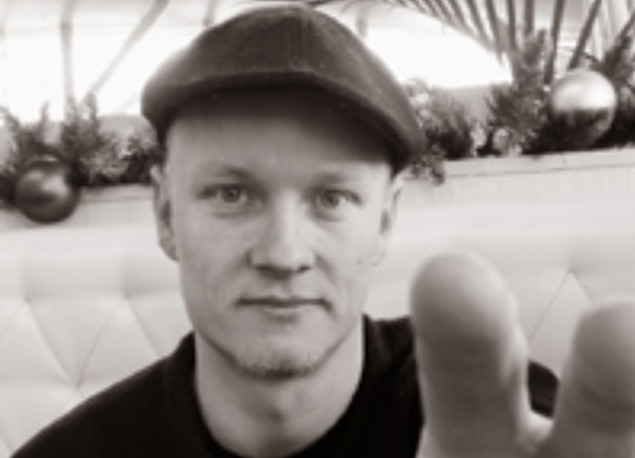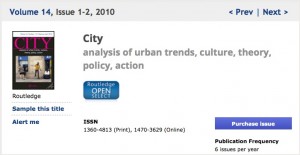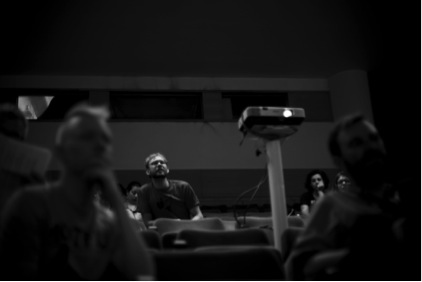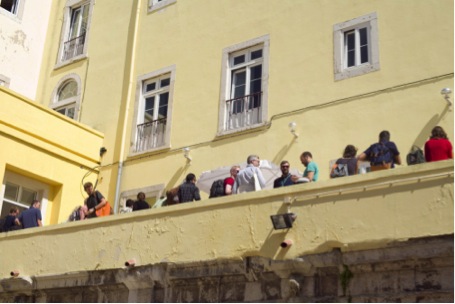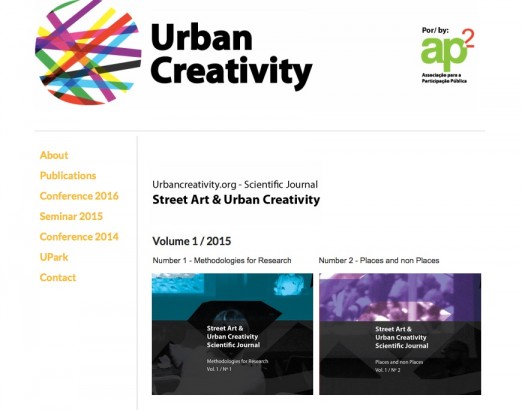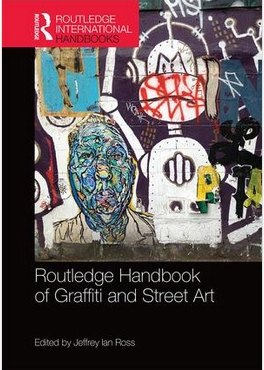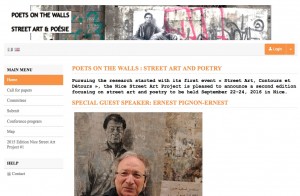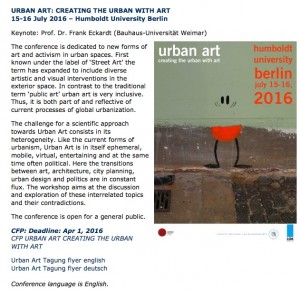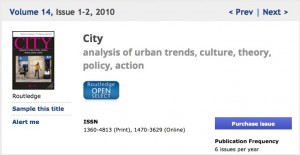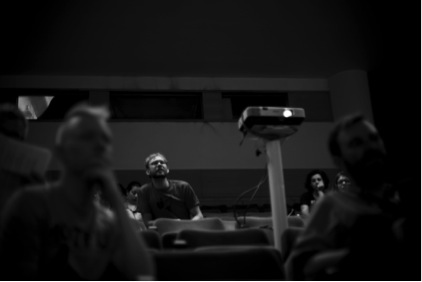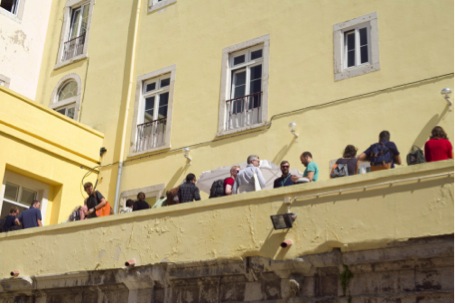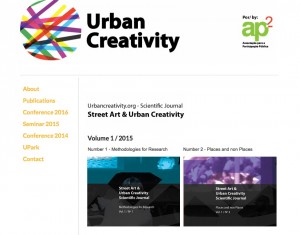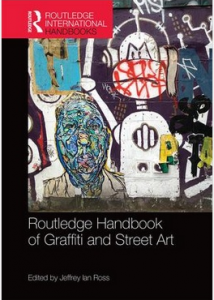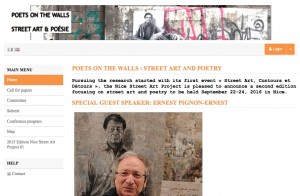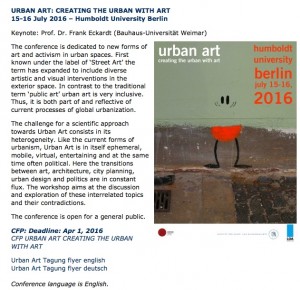Peter Bengtsen: Street art studies. Riflessioni su una disciplina di ricerca emergente
La versione originale inglese di questo articolo scritto da Peter Bengtsen (nella foto in alto) è riportata qui di seguito. For the original English version, click here.
A partire dai primi anni 2000, la street art si è manifestata sempre più come una componente onnipresente del paesaggio urbano. Parallelamente, le espressioni creative nello spazio pubblico urbano hanno attirato l’attenzione di un crescente numero di studiosi di discipline accademiche (ad es., storia dell’arte, studi visivi, sociologia, diritto, teoria critica giuridica, criminologia).
Data la diversa formazione dei ricercatori, la gamma dei metodi applicati e delle prospettive analitiche sulla street art è assai ampia, ed eterogenea è la tipologia di materiali empirici oggetto di studio. Molti studiosi si concentrano sui materiali visivi (ad es. schizzi, artefatti in strada, riproduzioni di opere di street art in volumi a stampa e on-line). Per comprendere la street art e il suo impatto sulla società si studiano anche altri materiali, come ad es. testi nelle numerose riviste dedicate e rivolte ad un pubblico non specialistico, pubblicazioni accademiche, discussioni sulla street art nei forum su internet e social media dedicati, testi di cataloghi di mostre, notizie riportate dalla stampa, decisioni di tribunali, testi legislativi, documenti di politiche pubbliche.
Fino a poco tempo fa, gli studiosi presentavano i risultati delle proprie ricerche sulla street art sotto forma di monografie (cfr. ad es. Reinecke 2007; Derwanz 2013; Bengtsen 2014; Young 2014) oppure in conferenze e riviste rivolte soprattutto a studiosi di specifiche discipline. In altre parole, gli storici dell’arte scrivevano soprattutto per gli altri storici dell’arte, i sociologi per gli altri sociologi, e così via. Non si mette in dubbio che sia utile discutere di street art con I colleghi della propria disciplina; tuttavia, il fatto di contestualizzare la ricerca sulla street art nell’ambito di una determinata disciplina ha in qualche misura frammentato la produzione di conoscenze e ostacolato l’interazione tra gli approcci adottati dai ricercatori.
Negli ultimi due anni si è invece assistito a tentativi fruttuosi di infrangere questo modello e creare una nuova disciplina che ho scelto di chiamare – in modo forse riduttivo – ‘street art studies’. Uno dei precursori di questa tendenza è stata la pubblicazione nel 2010 di un numero monografico della rivista City intitolato “Graffiti, street art and the city”, che include sette testi di studiosi di differenti discipline. Il fatto che tutti gli articoli della rassegna siano stati ampiamente citati nelle pubblicazioni accademiche successive testimonia del fatto che la presentazione congiunta di una serie di risultati di ricerca che affrontano il medesimo fenomeno da differenti prospettive, rivolgendosi a pubblici differenti, può creare un effetto sinergico: gli autori diventano sempre più consapevoli del lavoro altrui (il che può portare a collaborazioni future) e i loro contributi sono rivolti ad una compagine di lettori che supera i confini di ciascuna disciplina.
Se la rassegna pubblicata su City può essere considerata precursore di uno sforzo consapevole di riunire ricercatori di varia formazione ed inaugurare gli studi di street art come una disciplina a sè stante, la prima vera e propria manifestazione di tale tendenza si è prodotta alla Lisbon Street Art & Urban Creativity Conference del 2014.
Nel corso di tre giorni, la Conferenza ha ospitato 49 contributi di ricercatori di diverse discipline provenienti da 18 paesi. Molti dei contributi sono stati poi rielaborati e pubblicati in un volume di 46 capitoli su un’ampia gamma di temi relativi alla street art e alla creatività urbana. Inoltre, nel 2015 gli organizzatori della conferenza hanno istituito un comitato scientifico di studiosi di street art e creato lo Street Art & Urban Creativity Scientific Journal. La rivista ha finora pubblicato finora un volume (contenente due parti) accessibile gratuitamente in formato pdf su questo sito e acquistabile in copia cartacea su due siti (questo e questo). Un secondo numero della rivista è in preparazione sulla base dei contributi alla prossima edizione della conferenza di Lisbona del 16-18 giugno 2016.
Oltre all’iniziativa di Lisbona, avviata principalmente da giovani ricercatori, la pubblicazione agli inizi del 2016 dell’antologia multidisciplinare Routledge Handbook of Graffiti and Street Art dimostra che anche studiosi più affermati in ambienti accademici e della ricerca hanno dimostrato interesse per i vari aspetti di questa disciplina.
Anche se il crescente numero di pubblicazioni che includono molteplici prospettive sulla street art è positivo e necessario, personalmente reputo che le iniziative più suscettibili di far progredire la disciplina siano i seminari e le conferenze dedicate – non da ultimo perché questi eventi offrono agli studiosi un’opportunità di interagire sul piano professionale e sociale, creando legami e un senso di appartenenza ad una comunità intellettuale al di là dei confini di ciascuna disciplina. Data l’importanza di questo genere di interazione sociale, è positivo che altre iniziative siano emerse sulla scia della prima conferenza di Lisbona. Ad esempio, nel settembre 2015, il Nice Street Art Project ha organizzato a Nizza la conferenza “Street Art. Contours & Detours”. Gli atti sono liberamente scaricabili qui.
Una seconda edizione della conferenza intitolata “Poets on the Walls, Street Art & Poetry” è prevista per il settembre 2016.
Qualche mese prima, il 15-16 luglio 2016, l’Università Humboldt di Berlino ospiterà la conferenza “Urban Art: Creating the urban with Art”.
Negli ultimi quindici anni, nei dibattiti con gli studiosi interessati a vari aspetti della street art, ho spesso percepito che alcuni, adottando tale obiettivo di ricerca, si sentono un po’ outsider rispetto alla propria disciplina. Tutte le iniziative sopra citate mostrano che gli studiosi cercano sempre di più di interagire e connettersi con colleghi con interessi analoghi. Personalmente non auspico un distacco dall’ambito delle discipline accademiche riconosciute, ma è evidente che molti di noi sono entusiasti della nuova prospettiva che vede un progressivo emergere degli street art studies, destinati a diventare una vera e propria disciplina di ricerca poliedrica.
Bibliografia
Bengtsen, Peter. The Street Art World. Lund: Almendros de Granada Press 2014.
City, Vol. 14, Numeri 1-2, 2010.
Derwanz, Heike. Street Art-Karrieren. Neue Wege in den Kunst- un Designmarkt. Bielefeld: Transcript Verlag 2013.
Reinecke, Julia. Street-Art. Eine Subkultur zwischen Kunst und Kommerz. Bielefeld: Transcript Verlag 2007.
Ross, Jeffrey Ian. (ed.). Routledge Handbook of Graffiti and Street Art. New York & London: Routledge 2016.
Young, Alison. Street Art, Public City. Law, Crime and Urban Imagination. New York & London: Routledge 2014.
Street art studies: some thoughts on an emerging academic discipline
By Peter Bengtsen, Department of Arts and Cultural Sciences, Lund University, Sweden
Since the beginning of the 2000s, street art has become an increasingly ubiquitous part of the urban landscape. In parallel with this development, creative expressions in urban public space have caught the attention of a growing number of scholars from academic disciplines like art history, visual studies, sociology, law, critical legal theory and criminology, to name but a few.
Given the heterogeneity of the interested researchers’ disciplinary backgrounds, the range of applied methods and analytical perspectives on street art has been wide, and the type of relevant empirical material that has been studied has been varied. Visual material (e.g. sketches, artworks on the street, reproductions of street artworks in books and online) is central to many scholars. However, other material (e.g. texts in the abundant printed popular publications on street art, previous academic publications, discussions about street art on dedicated internet forums and social media, exhibition catalogue texts, news stories, court decisions, legislative texts, public policy documents) is also studied to understand street art and its role in and impact on society.
Until recently, academics have presented the results of their research efforts on street art either in monographs (see for example Reinecke 2007; Derwanz 2013; Bengtsen 2014; Young 2014) or through conferences and journals that primarily cater to scholars from specific academic disciplines. In other words, art historians have primarily been writing for other art historians, sociologists have been writing for other sociologist, and so on. While it can certainly be useful to discuss street art with colleagues from one’s own discipline, always embedding street art research in these discipline-specific contexts has to some extent fragmented the knowledge production and impeded the interaction across established disciplinary boundaries of researchers interested in street art.
In the last couple of years, however, there have been fruitful attempts to break this pattern and create a new discipline which I have chosen to – somewhat reductively – here call street art studies. One of the forerunners of what is happening today was the publication of a feature on “Graffiti, street art and the city” in the journal City in 2010, which included seven texts by scholars from several different disciplines. That all the featured articles have been widely cited in subsequent academic publications is a testament to the fact that presenting together a number of research outputs that approach the same phenomenon from different perspectives, and therefore appeal to different audiences, can create a synergetic effect: authors become more aware of each other’s work (which may lead to future collaborations), and their contributions are exposed to a readership beyond their own formal disciplines.
If the feature in City can be seen as a precursor of a conscious effort to bring together researchers from disparate backgrounds and establish street art studies as a discipline in its own right, the first wave proper arguably came with the Lisbon Street Art & Urban Creativity Conference in 2014.
Over the course of three days in early July, 49 papers were presented by researchers from 18 different countries and a number of different academic disciplines. Many of the conference papers were later reworked and published in a book containing 46 chapters on a wide variety of topics related to street art and urban creativity. In addition, in 2015 the conference organizers brought together a scientific committee of street art scholars and established the Street Art & Urban Creativity Scientific Journal. The journal has so far published one volume (containing two issues), which can accessed freely in PDF format here and can be purchased in hard copy here and here.
A second volume of the journal is currently being prepared on the basis of the contributions to the next instalment of the Lisbon conference which will take place on 16-18 June 2016. In addition to the Lisbon initiative, which has been undertaken primarily by junior researchers, the publication in early 2016 of the multidisciplinary anthology Routledge Handbook of Graffiti and Street Art demonstrates that more established agents within research and academic publishing have also taken an interest in the many facets of the field.
While the increasing number of publications that include multiple perspectives on street art is positive and necessary, I currently see the seminars and conferences dedicated to street art as the initiatives that have most potential to move the discipline of street art studies forward. This is not least because these events afford scholars an opportunity to interact both professionally and socially, thus potentially creating bonds and a sense of belonging to an intellectual community beyond established disciplinary boundaries. Given the importance of this kind of social interaction, it is positive that more initiatives have emerged in the wake of the first Lisbon conference. Thus, in September 2015, the Nice Street Art Project arranged the conference “Street Art. Contours & Detours” in Nice, France. The proceedings are freely available here.
A second instalment of the conference entitled “Poets on the Walls, Street Art & Poetry” is planned for September 2016.
And a bit earlier in the year, on 15-16 July 2016, Humboldt University in Berlin will host the conference “Urban Art: Creating the urban with Art”.
In conversations over the past 15 years with scholars who investigate different aspects of street art, I have often heard that people feel a bit like outsiders within their own established disciplines because of their research focus. The initiatives mentioned above all point towards these scholars increasingly seeking to interact with and connect to likeminded peers. While I do not advocate severing ties with established academic disciplines, it is clear to me that we are many who are excited at the prospect of street art studies continuing to emerge and eventually coming into its own as a multifaceted academic discipline.
References
Bengtsen, Peter. The Street Art World. Lund: Almendros de Granada Press 2014.
City, Vol. 14, Issue 1-2, 2010.
Derwanz, Heike. Street Art-Karrieren. Neue Wege in den Kunst- un Designmarkt. Bielefeld: Transcript Verlag 2013.
Reinecke, Julia. Street-Art. Eine Subkultur zwischen Kunst und Kommerz. Bielefeld: Transcript Verlag 2007.
Ross, Jeffrey Ian. (ed.). Routledge Handbook of Graffiti and Street Art. New York & London: Routledge 2016.
Young, Alison. Street Art, Public City. Law, Crime and Urban Imagination. New York & London: Routledge 2014.
Category: Arte e Poesia, Osservatorio Europa, Osservatorio sulle città
